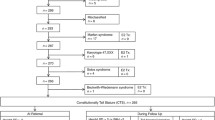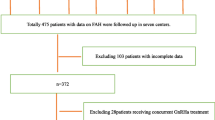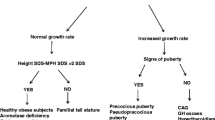Abstract
In 135 women and 85 men who initially presented for tall stature, the outcome in treated (56 women and 33 men; cases) and untreated (controls) was investigated. At the time of height prediction, cases were significantly taller (P≤0.03) than the controls, they had higher target heights (P<0.001) and adult height predictions (P<0.001) (according to Bailey and Pinneau) compared to the controls. Bone age (according to Greulich and Pyle) and chronological age were well matched in both groups. Final height was measured after cessation of growth at a mean age above 21.5 years. The final height prediction according to Bailey and Pinneau (BP method) overestimated the final height in controls. The mean error of estimation was −0.14 cm (±3.10) in women, and −1.86 cm (±4.37) in men. Age at the time of prediction did not significantly correlate with the degree of the prediction error. Sex hormone therapy comprised a daily oral dose of 7.5 mg conjugated oestrogens in girls (plus 5 mg dydrogesterone for 10 days a month), while boys received 500 mg testosterone enantate, intramuscularly, every 2 weeks. Therapy was well tolerated. The mean corrected effect of height reducing therapy was 3.6 cm (range: 11.9 cm to −3.3 cm) in women and 4.4 cm (range: 14.2 cm to −5.2 cm) in men. Therapy was significantly more effective when started at an earlier chronological (P<0.01) and bone age (P<0.01). The residual mean growth, after therapy was stopped, was 1.8 (±1.6) cm in women and 3.1 (±2.3) cm in men. In men, post-treatment growth was inversely correlated to chronological age (P<0.01) and bone age (P<0.05) at the end of treatment, while these correlations were not significant in women. Both groups had a higher educational level than the normal population. Treated tall women reported teasing because of tallness more frequently than controls. In tall men, practical issues such as clothing size predominated. Maximum tolerated height in males was 200 cm and in females 180 cm, thus being nearly analogous to the actual professional criteria for treatment recommendation. A positive attitude to treatment was documented in over 90% of treated individuals.
Conclusions Our results show that the BP method gives acceptable adult height predictions in girls, but less accurate predictions in boys. The treatment with high doses of sex hormones was low effective in both sexes and showed a wide range of response. For success, treatment must be initiated in early puberty and terminated late. The answers to a questionnaire revealed no major psychological or social maladjustment of treated individuals compared to those untreated.
Similar content being viewed by others
Author information
Authors and Affiliations
Additional information
Received: 18 March 1997 / Accepted in revised form: 20 June 1997
Rights and permissions
About this article
Cite this article
Binder, G., Grauer, M., Wehner, A. et al. Outcome in tall stature. Final height and psychological aspects in 220 patients with and without treatment. Eur J Pediatr 156, 905–910 (1997). https://doi.org/10.1007/s004310050740
Issue Date:
DOI: https://doi.org/10.1007/s004310050740




